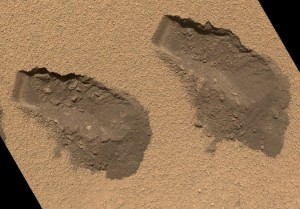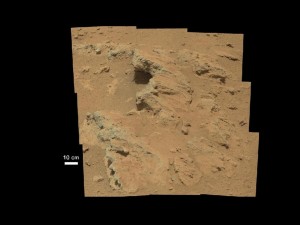The Mars rover Curiosity has drilled the first ever hole into Martian rocks. From Alicia Chang:
Using the drill at the end of its 7-foot-long robotic arm, Curiosity on Friday chipped away at a flat, veined rock bearing numerous signs of past water flow. After nearly seven minutes of pounding, the result was a drill hole 2 1/2 -inches deep.
The exercise was so complex that engineers spent several days commanding Curiosity to tap the rock outcrop, drill test holes and perform a ‘‘mini-drill’’ in anticipation of the real show. Images beamed back to Earth overnight showed a fresh borehole next to a shallower test hole Curiosity had made earlier.
‘‘It was a perfect execution,’’ drill engineer Avi Okon at the NASA Jet Propulsion Laboratory said Saturday.
Previous Mars landings carried tools that scraped away the exterior layers of rocks and dirt. Opportunity and Spirit — before it died — toted around a rock grinder. Phoenix, which touched down near the Martian north pole in 2008, was equipped with an ice rasp to chisel frozen soil.
Now onto analyzing the rock’s chemical make up.



